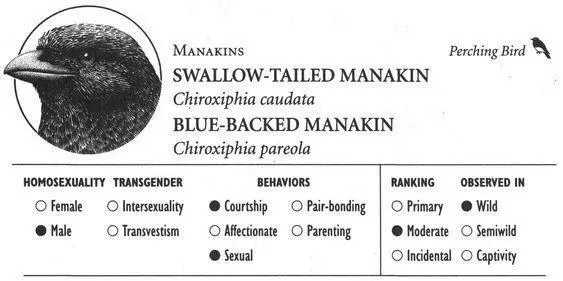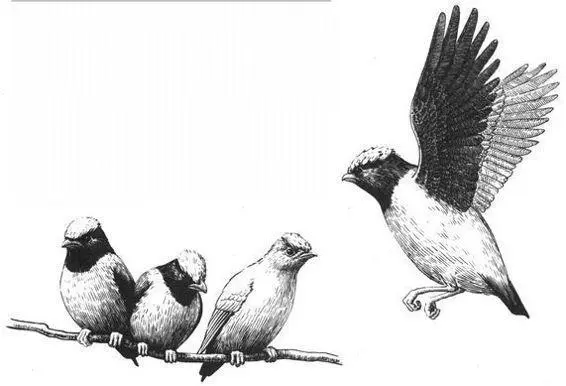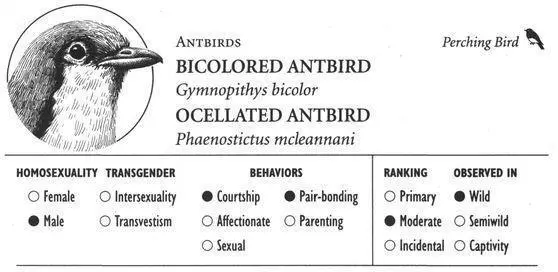*Trail, P. W. (1990) “Why Should Lek-Breeders Be Monomorphic?” Evolution 44:1837–52.

SWALLOW-TAILED MANAKIN
IDENTIFICATION: Adult males are bright blue with an orangish red crown and a black head and wings; females and yearling males are all green, while younger adult males are green or blue-green with an orange crown. DISTRIBUTION: Eastern Brazil, Paraguay, northwestern Argentina. HABITAT: Moist forests. STUDY AMA: Southeastern Brazil.
BLUE-BACKED MANAKIN
IDENTIFICATION: Adult males are black with a red crown and a light blue patch on the back; yearling males and females are all green, while younger adult males are green with a reddish crown. DISTRIBUTION: Tobago, the Guianas, the Amazon Basin. HABITAT: Forest undergrowth, woodland. STUDY AREA: Tobago, West Indies; subspecies C.p. atlantica.
Social Organization
Male Swallow-tailed Manakins form stable, long-term associations of four to six individuals that spend virtually all of their time together; they remain with each other throughout the mating season and usually from year to year as well. These groups display together on traditional courts or LEKS. The mating system is polygamous, with males (and probably also females) copulating with multiple partners, although large numbers of males are nonbreeders. Blue-backed Manakins have a similar social organization.
Description
Behavioral Expression: Male Swallow-tailed Manakins perform an elaborate group courtship ritual, the JUMP DISPLAY. Sometimes this display is directed toward females, sometimes toward yearling or younger adult males (the latter resembling females in their green plumage, but distinct because of their red-orange caps), and less commonly toward another adult male. To begin a homosexual jump display, a group of two to three adult males gathers on a display perch on their lek, lined up side by side, with the (younger) male they are displaying to perched at the head of this row. While uttering squawking notes that resemble a chorus of frogs, the adult males crouch down, quiver their bodies, and shuffle their feet, forming a collective vibrating mass. The courting males then take turns jumping up and hovering in front of the younger male while giving a sharp dik-dik-dik call, landing next to him. As each male jumps, the others slide down the perch toward his former position, repeating the sequence each time to produce a continuous rotation of flying and sliding birds, whose orange-red crowns collectively form a “whirling torch” in front of the courted bird. During this coordinated display, the younger male usually sits motionless in an upright posture. Males also sometimes mount each other and attempt copulation.
A similar revolving courtship display is performed by pairs of male Blue-backed Manakins for a third bird, which is sometimes a younger male. The display begins with a duet between the displaying males in order to attract a potential mate: the two birds perch side by side and utter perfectly synchronized chup calls. Once a younger male arrives, they begin courting him with their CATHERINE WHEEL DISPLAY. Each adult male jumps up alternately and flutters backward, “leapfrogging” over his partner, who moves forward to replace him in a precisely timed sequence that resembles two juggling balls. This is repeated up to 60 times to create a “cartwheel” of flying birds, oriented toward the male being courted, that gradually gets faster and faster. All the while the displaying males utter vibrant nasal or buzzing sounds that resemble the twanging of a Jew’s harp. At the peak of the dancing frenzy, one of the adult males calls sharply and his partner disappears; the first male then begins courting the younger male one-on-one. He crisscrosses his display perch in a buoyant, butterfly-like flight, alighting in front of the other male every once in a while to lower his head, vibrate his wings and opalescent blue back, and display his brilliant red crest with its two extendable horns. During this performance, the younger male crouches and constantly turns to face the older male courting him, sometimes also responding with a similar bouncing “butterfly” flight across the display perch.
Homosexual courtship in a group of Swallow-tailed Manakins: one male ( right ) hovers in front of a younger male as the other males prepare to perform their part in the “jump display”

Frequency: The overall proportion of courtships or mounts that occur between males is not yet known for either of these species, although they may be relatively infrequent. However, two of three observed “butterfly” courtship displays in a study of Blue-backed Manakins were directed toward males, while in a two-year study of Swallow-tailed Manakins, only ten heterosexual matings were recorded. It is possible, therefore, that same-sex activity represents a sizable proportion of all courtship and/or sexual activity.
Orientation: Only one out of every four to six male Swallow-tailed Manakins displaying on the lek ever copulates with females; thus, a large proportion of males are not involved directly in male-female sexual (mounting) activity, although they do participate in both heterosexual and homosexual courtships. A similar pattern occurs in Blue-backed Manakins.
Nonreproductive and Alternative Heterosexualities
In addition to significant numbers of nonbreeding males, Swallow-tailed Manakin populations are characterized by several other less-than-optimal heterosexualities. Only about a third of male-female courtships ever result in mating: half of the time, females being courted simply leave, while in the remainder of cases other males disrupt the courtship displays. However, when mating does take place, a female may copulate with the same male up to six times in one visit; the same is also true for Blue-backed Manakins.
Sources
*asterisked references discuss homosexuality/transgender
Foster, M. S. (1987) “Delayed Maturation, Neoteny, and Social System Differences in Two Manakins of the Genus Chiroxiphia. ” Evolution 41:547–58.
———(1984) “Jewel Bird Jamboree.” Natural History 93(7):54–59.
———(1981) “Cooperative Behavior and Social Organization in the Swallow-tailed Manakin ( Chiroxiphia caudata ).” Behavioral Ecology and Sociobiology 9:167-77.
Gilliard, E. T. (1959) “Notes on the Courtship Behavior of the Blue-backed Manakin ( Chiroxiphia pareola ).” American Museum Novitates 1942:1–19.
*Sick, H. (1967) “Courtship Behavior in the Manakins (Pipridae): A Review.” Living Bird 6:5-22.
*———(1959) “Die Balz der Schmuckvögel (Pipridae) [The Mating Ritual of Jewel Birds].” Journal für Ornithologie 100:269–302.
*Snow, D. W. (1976) The Web of Adaptation: Bird Studies in the American Tropics . New York: Quadrangle/New York Times Book Co.
———(1971) “Social Organization of the Blue-backed Manakin.” Wilson Bulletin 83:3–38.
*———(1963) “The Display of the Blue-backed Manakin, Chiroxiphia pareola, in Tobago, W.I.” Zoologica 48:167–76.

IDENTIFICATION: Small (5–7 inch) birds with brown and rufous plumage and a bluish gray patch around the eyes; Ocellateds have a distinctive scalloped pattern on the back feathers. DISTRIBUTION: Central America and northwestern South America from Honduras to Ecuador. HABITAT: Rain forest undergrowth. STUDY AREA: Barro Colorado Island, Panama.
Читать дальше















